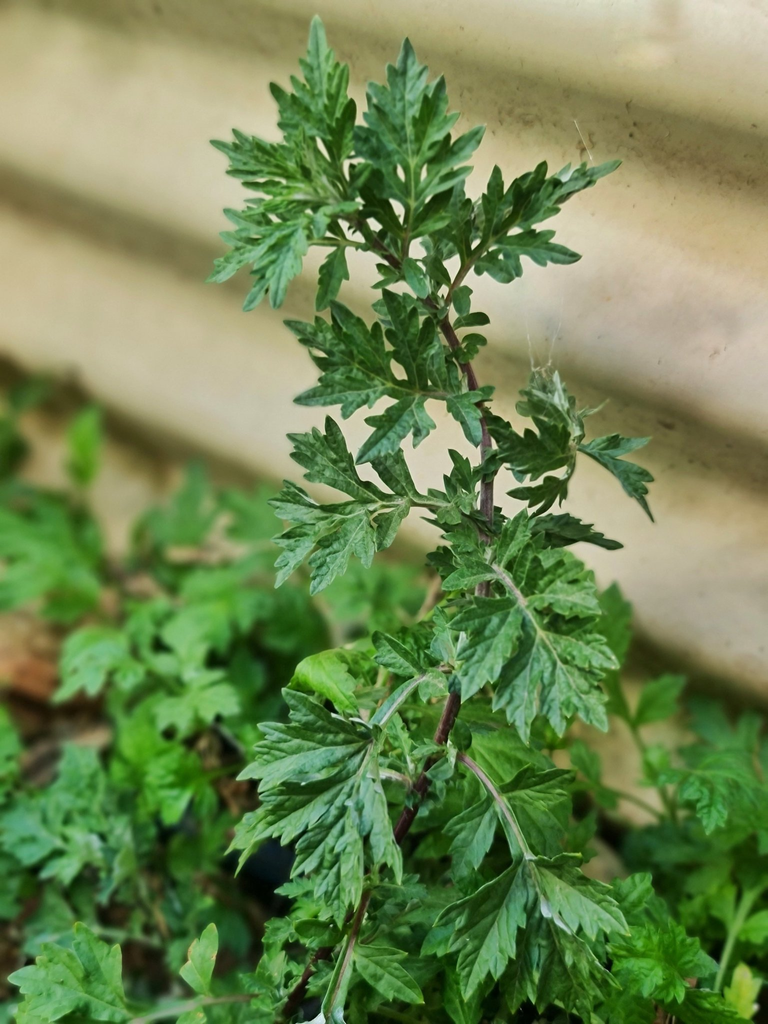
Common names: Mugwort, Felon Herb, Old Man, Chrysanthemum herb, Sagewort, Nāgadamanī, Damanka, Ai Ye, Yomogi, Ssuk
Taxonomic name: Artemisia vulgaris
Related herbs: A. absinthium, A. argyi (Chinese Mugwort), A. princeps (Korean Mugwort), A. japonica (Japanese Mugwort), Sweet Annie (Artemisia annua)
Area of origin: Europe, Asia, North Africa.
Parts used: leaves, stem
Can be used for: worms and parasites, fatigue, poor appetite or digestion, tumors , masses and lumps, insect repellent, brings and helps you remember dreams, antidote to Opium, some menstrual and uterine troubles. Used as moxa for moxibustion.
Actions: , opens, clears, disperses, builds qi, moves blood, carminative, cholagogue/choleretic, tonic, nervine sedative, antispasmodic, anthelmintic, laxative
Taste: warm, dry, pungent, bitter, aromatic
Tissue states: wind, damp, cold, depression
Energetics: warming, drying, relaxant, relaxant, stimulant
Healing constituents: flavonoids, essential oils, thujone, phenolic acids, coumarins, sterols, carotenoids, vitamins, and sesquiterpene lactones, vulgarin, artemisinin, scopoletin, camphene, camphor, sabinene, derivatives of quercetin and kaempferol, vitamin C
Warnings: some folks can be terribly allergic to Mugwort pollen. Eating too much of any bitter herb can bring on stomach aches and diarrhoea. Avoid it you have stomach ulcers. Minor skin irritation can occur in some people and the Thujone content makes it inadvisable to use Mugwort during pregnancy. Avoid if you suffer seizures.
Description
Mugwort is a clumping perennial that spreads through rhizomes. It can become woody over time. It has deeply lobed and divided leaves that are positioned alternately on the stem. The leaves are a dark green above and silvery white underneath because of the presence of fine white hairs.
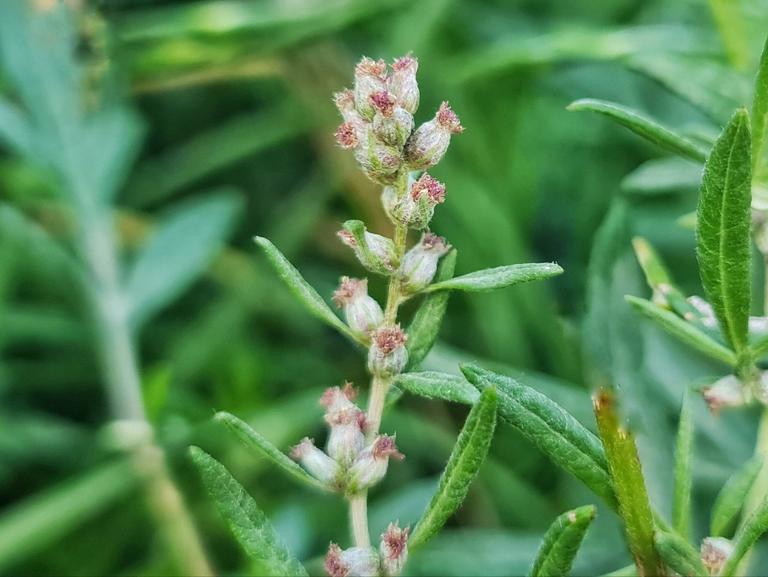
The smell of Mugwort leaves when crushed is distinctive due to the presence of a healing oil. Mugwort stems are angular and inconspicuous green/brown flowers are borne in clusters on the upper stem. The plant does set seeds sometimes but reproduction is mostly done via underground rhizomes.
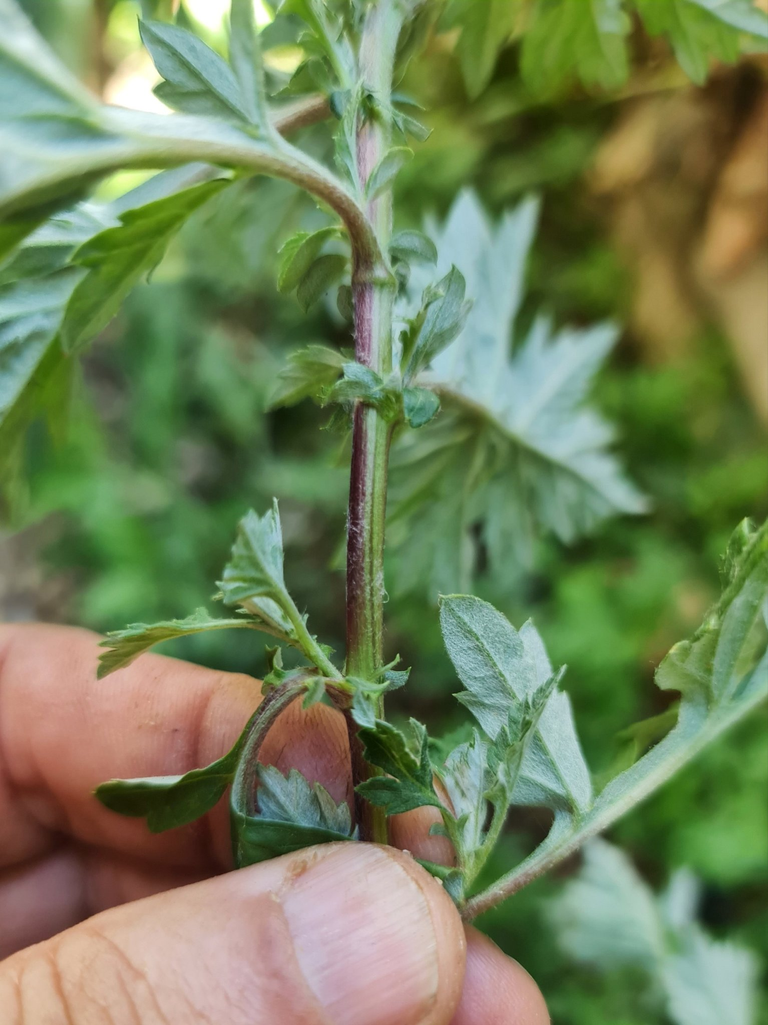
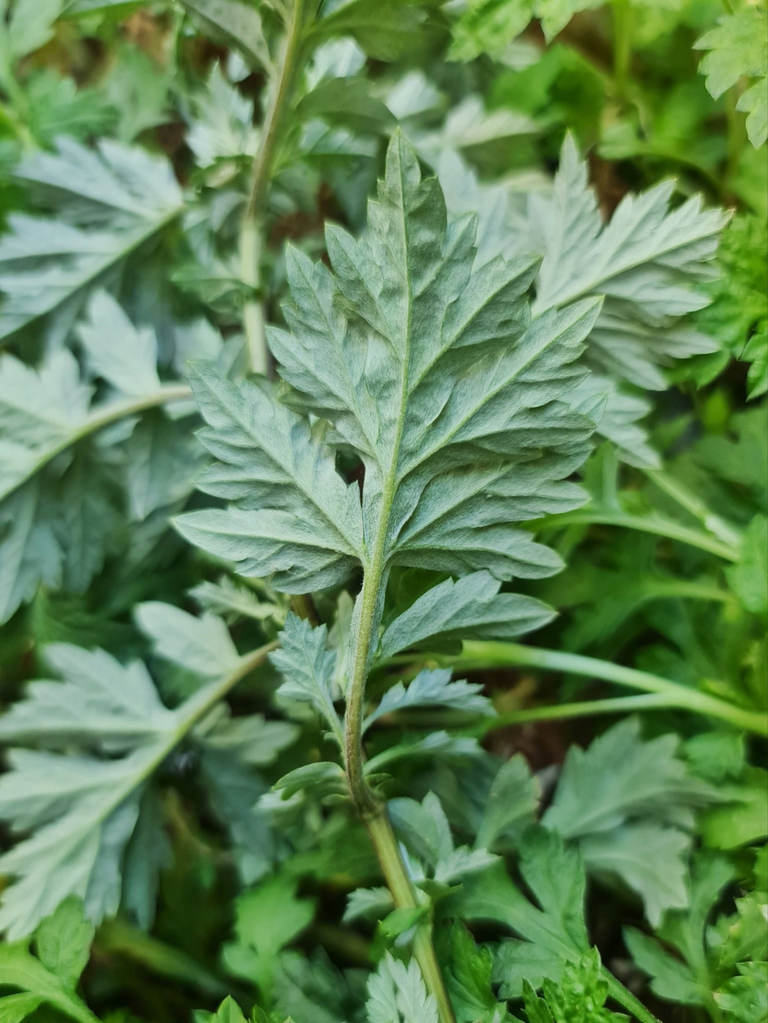
Medicinal use
If I were to create a list of my top 10 plants (though I won’t because I dislike those clickbait posts), Mugwort would be in the top 5. It is such a medicinally useful plant that different varieties have been used by different cultures and systems of healing for millennia. Fortunately for us, the species used are pretty similar and are used for similar things. Ayurveda calls it ‘Damanka’ and TCM calls it ‘Ai Ye’. It is also related to the Wormwoods and Sagebrushes of North America where Indigenous folks had their uses for it too.
It is commonly used as a food to get that goodness into those who eat it, many cultures use the young shoots and buds as food staples. Japan, Korea, China, and even Germany use it in various dishes and it is the key ingredient in strong bones vinegar.
Across cultures, we see the Mugworts used for their warming, bitter energies through their aromatic properties. I’ve said in other herb pages that bitters generally cool, but Mugwort has a warming action because of its pungency.
Both the bitter and aromatic properties affect digestion. They stimulate the gallbladder and liver to excrete bile, aiding digestion of fats and providing a laxative effect. It has excellent carminative properties that stomach and GI tract. The anthelmintic property ascribed to Mugwort undoubtedly comes from the same bitters and aromatics and maybe even the laxative effect as well as it moves out obstructions and foreign objects (not that you should have too many foreign objects in your digestive tract – here, I’m writing about worms). Mugwort’s bitterness has a draining, downward action so it helps with elimination through both the bowels, urinary tract and menses.
Mugwort is very useful to women. It is, afterall the herm of Artemis,the goddess of, among other things, chastity and childbirth. It is a key herb to use to increase blood flow to the reproductive organs and relaxes tension and spasm in the uterus. As an emmenagogue, and an herb that can directly affect the uterus, it is contraindicated in pregnancy. However, Mugwort, decocted in water and applied as a plaster to the lower abdomen or vagina is said to promote speedy labor. I’ve no experience of this myself but the practice was widespread.
The herb is a stimulant in several ways. The increased blood flow and improved digestion help boost energy and the thujone in it can excite the central nervous system (so much so that too much can cause seizures). My main, personal use for Mugwort is to repress androgen, a key sex hormone of which I make bucket loads too much. It’s got me into trouble a few times.
One of the coolest aspects of Mugwort’s healing powers is its ability to stimulate the depth and clarity of dreams and to help you remember them on waking. I always dream as a full sensory experience, identical to waking, except for a few ‘tells’ but Mugwort dreams are something special! You only need to put a sprig in your pillow case to get the effect.
One way I love to use Mugwort is in moxibustion, practice in TCM that I learned in the Philippines. The crushed, dried herb is placed on an appropriate acupuncture point and burned. Mugwort burns slowly and with an amazing heat that penetrates right into the body. I’ve used it for many issues related to cold and stagnation and it works a treat. My preferred method is the compressed mugwort cigars that you hold over the point but I’ve also used dried mugwort directly on special acupuncture needles designed for the job. The older the moxa the better too, I have some special moxa cigars that are now close to 60 years old. I was given them by a herbolario to keep until my libido started to wane. The herbolario didn’t speak English and my knowledge of his language was limited but the miming he did left no room for misinterpretation. It was one of the funniest moments of my life.
Adding Mugwort to healing oils to helps carry the benefits deeply into the body.
Adding Mugwort to healing oils to helps carry the benefits deeply into the body.
Preparing and using Mugwort
Mugwort makes an excellent vinegar, called ‘strong bones vinegar’ that is traditionally used for improving bone strength. Dried and aged, it makes the moxa used in TCM.
Mugwort is a versatile herb, you can prepare it pretty well any way you can think of. Use it as food for helping your digestive respiratory and circulatory issues.
Dried Mugwort retains much of the herb’s potency and aged, dried Mugwort can be used for moxibustion to stimulate blood flow and impart warmth into cold and deficient areas.
I like to make Mugwort oil and add some of this to many of my other, more warming oils. Mugwort helps to carry the healing characteristics of the oil deeper into the body. Mugwort oil and salve can be used to stimulate blood flow in the treatment of bruises and sprains, it also relieves external itching in skin complaints.
Mugwort tincture can be taken for many digestive complaints, especially related to the liver. It can also benefit the respiratory tract during cough and cold season.
Mugwort can be used as an essential oil too. Here its microbe killing effects shine.
A good sized sprig of Mugwort in one’s pillow case brings interesting, memorable dreams. Traditionally, it was put under one’s pillow but I’ve found in the pillow case works best. Maybe pillow materials were different back in the old days?
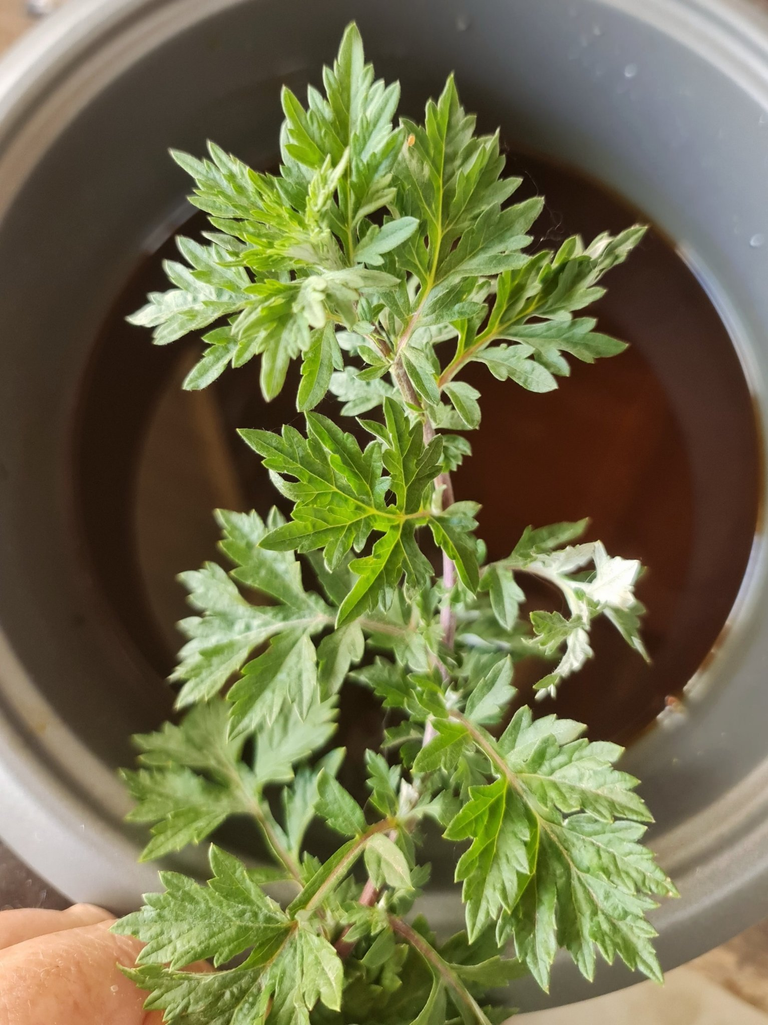
Some of you may have seen that I've been writing a series of posts about herbs and making herbal remedies at home. I want to share what I know of this topic so that, as the world gets crazier, folks will have other avenues of medical care, namely those of themselves and their community. If you look back over this blog, you can see heaps of info on the topic, plus loads and loads of posts on herbs and using Australian bushfoods from a white perspective. If you haven't been around on in the @hivegarden and @naturalmedicine communities for long, you may be interested in looking back. There's w-a-a-a-a-y too much there for me to repost and the Hive system doesn't let you vote on old posts so, if you're happy with what you find, I believe that there is now a tip option...




I like Mugwort a lot, especially its smell. ☘️☘️☘️ Without this plant there would be no absynthe. 😜
So true! Do you have access to the good stuff? Our absinthe out here is just flavoured.
Sadly, but nope! (Just have heard a very cool and extensive video lecture on absinthe history a week ago, right before stumbled upon your post! a nice coincidence). ☘️
Good timing
I thought I needed to drink it in tea form to get the dreamy effect. I have plenty that I've been drying but never actually started using it, yet...
Luckily it is invading the garden plot that my mother likes to be in charge of. It came to us or of nowhere. I have a good supply now.
I need to remember to cut a decent sized sprig for my pillow case this evening!
Thank you for these articles.
This series is great.
Thank you. I'm redoing all of my old herbal posts with much, much more info and clarity and adding many more common, garden and local herbs.
Your mother is lucky to have it as a companion in her garden. Have you tried it as a tea before bed time before? If I take it in that way, I have so many active dreams that I'm exhausted by morning!
I think I tried just a few times and then either forgot about it or ran out or both. But I did drink some of the tea a few moments ago. And now I'm off to bed.
Hahaha! Good morning! You know... I do actually recall some dreams with a distinct maritime theme, me having a sword and some kind of power over water!
Very symbolic!
Thank you. As herbs become more important and commercial medical treatment less accessible and more expensive, I'll be sharing a lot more with my fellow silver bloggers. I'm 60 on the 10th of May no silver in the hair yet but my beard...